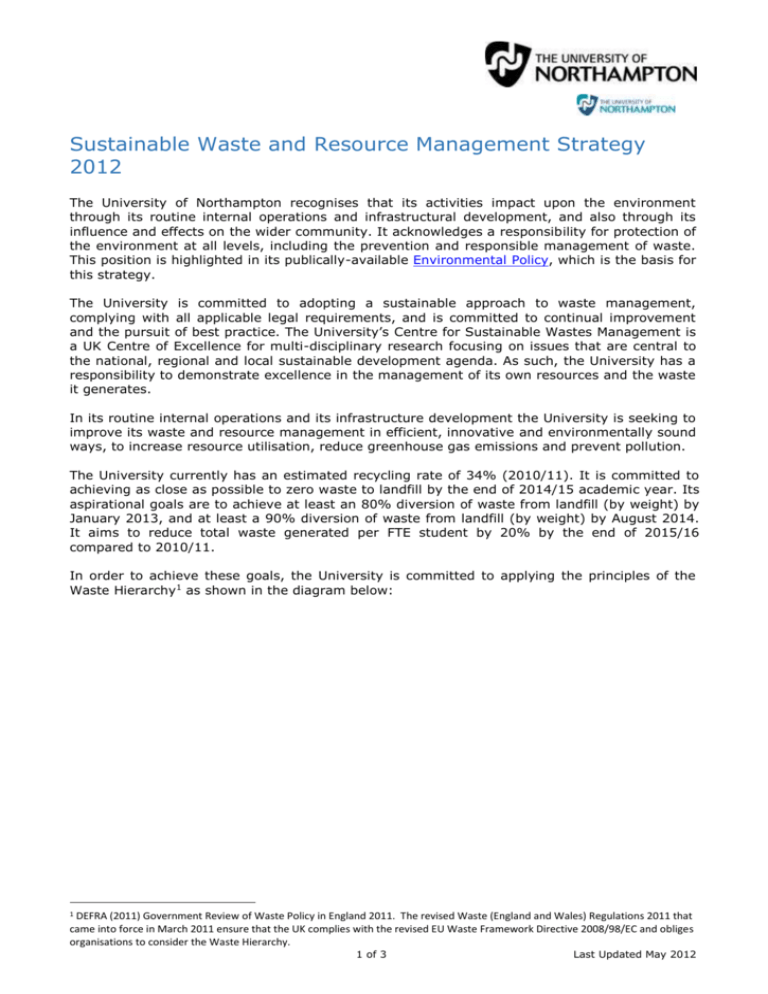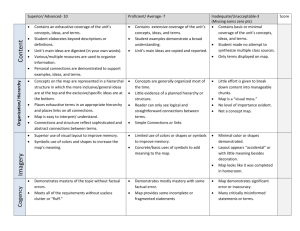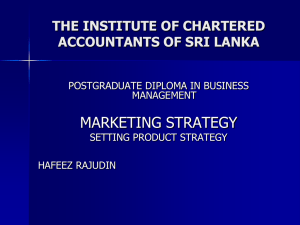Sustainable Waste and Resource Management
advertisement

Sustainable Waste and Resource Management Strategy 2012 The University of Northampton recognises that its activities impact upon the environment through its routine internal operations and infrastructural development, and also through its influence and effects on the wider community. It acknowledges a responsibility for protection of the environment at all levels, including the prevention and responsible management of waste. This position is highlighted in its publically-available Environmental Policy, which is the basis for this strategy. The University is committed to adopting a sustainable approach to waste management, complying with all applicable legal requirements, and is committed to continual improvement and the pursuit of best practice. The University’s Centre for Sustainable Wastes Management is a UK Centre of Excellence for multi-disciplinary research focusing on issues that are central to the national, regional and local sustainable development agenda. As such, the University has a responsibility to demonstrate excellence in the management of its own resources and the waste it generates. In its routine internal operations and its infrastructure development the University is seeking to improve its waste and resource management in efficient, innovative and environmentally sound ways, to increase resource utilisation, reduce greenhouse gas emissions and prevent pollution. The University currently has an estimated recycling rate of 34% (2010/11). It is committed to achieving as close as possible to zero waste to landfill by the end of 2014/15 academic year. Its aspirational goals are to achieve at least an 80% diversion of waste from landfill (by weight) by January 2013, and at least a 90% diversion of waste from landfill (by weight) by August 2014. It aims to reduce total waste generated per FTE student by 20% by the end of 2015/16 compared to 2010/11. In order to achieve these goals, the University is committed to applying the principles of the Waste Hierarchy1 as shown in the diagram below: 1 DEFRA (2011) Government Review of Waste Policy in England 2011. The revised Waste (England and Wales) Regulations 2011 that came into force in March 2011 ensure that the UK complies with the revised EU Waste Framework Directive 2008/98/EC and obliges organisations to consider the Waste Hierarchy. 1 of 3 Last Updated May 2012 The Waste Hierarchy shows the most environmentally sound option at the top i.e. not generating waste in the first place, with the least environmentally favourable option, disposal, at the bottom. The aim of using the Waste Hierarchy is for University staff, students and contractors to consider making decisions that have outcomes further up the hierarchy, so moving away from disposal, towards preventing waste in the first place. In order to put the Waste Hierarchy into practise, the University wants to create a culture where decisions are considered and choices examined in light of the following priorities: Order of consideration 1st Activity What should take place: Prevention Measures should be taken to eliminate the need for equipment or materials, or use alternative options before a substance, material or product needs to become a waste. Look for opportunities to use products or components again within the University, or pass them on to external organisations for re-use. Segregate and collect items at source, where feasible, for reprocessing internally or by external organisations. Investigate possible on-site reprocessing of organic materials. Collecting residual materials for off-site use by organisations where the waste serves a useful purpose e.g. energy recovery, use as fuel or for backfilling operations. Send to incineration or landfill as the last option. 2nd Prepare for Re-use 3rd Recycling 4th Other recovery 5th Disposal Through waste audits and monitoring, the University has identified the following primary waste streams for consideration in light of the Waste Hierarchy: Construction and refurbishment waste; Household-type waste (from offices, teaching rooms and Halls of Residence) including plastics, paper, cardboard, metal, glass etc; Biodegradable waste (from catering outlets, Halls of Residence and grounds); Confidential waste (paper and media); 2 of 3 Last Updated May 2012 Chemical waste (from the School of the Arts, the School of Science & Technology and grounds maintenance); Sanitary and low-level clinical waste (from first aid rooms and the School of Health); Waste Electrical and Electronic Equipment (WEEE); Furniture and other bulky wastes; Bric-a-Brac (from Halls of Residence when students move out). The University has identified seven key principles that it proposes to undertake in order to monitor and manage its waste and resources more effectively: 1. Identify where, what and why waste is being produced; 2. Develop a transparent and accountable system to measure, record & report waste arisings; 3. Develop Key Performance Indicators (KPIs) and benchmarks; 4. Set targets to reduce waste production; 5. Identify ways of moving up the Waste Hierarchy to improve resource efficiency; 6. Separate different waste streams; 7. Involve staff, students and contractors through awareness raising, training and two-way dialogue. 3 of 3 Last Updated May 2012






